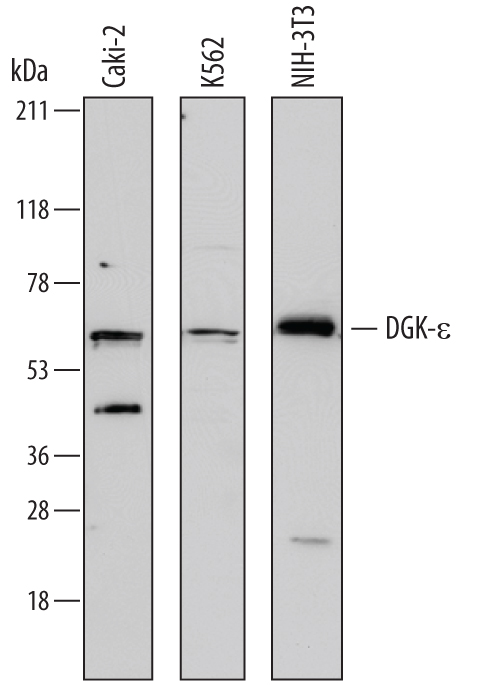Human/Mouse DGK-epsilon Antibody Summary
Asn314-Arg435
Accession # P52429
Applications
Please Note: Optimal dilutions should be determined by each laboratory for each application. General Protocols are available in the Technical Information section on our website.
Scientific Data
 View Larger
View Larger
Detection of Human and Mouse DGK‑ epsilon by Western Blot. Western blot shows lysates of Caki-2 human clear cell carcinoma epithelial cell line, K562 human chronic myelogenous leukemia cell line, and NIH-3T3 mouse embryonic fibroblast cell line. PVDF membrane was probed with 1 µg/mL of Sheep Anti-Human DGK-e Antigen Affinity-purified Polyclonal Antibody (Catalog # AF7069) followed by HRP-conjugated Anti-Sheep IgG Secondary Antibody (Catalog # HAF016). A specific band was detected for DGK-e at approximately 65 kDa (as indicated). This experiment was conducted under reducing conditions and using Immunoblot Buffer Group 1.
 View Larger
View Larger
DGK‑ epsilon in Human Brainstem. DGK-e was detected in immersion fixed paraffin-embedded sections of human brainstem using Sheep Anti-Human DGK-e Antigen Affinity-purified Polyclonal Antibody (Catalog # AF7069) at 10 µg/mL overnight at 4 °C. Tissue was stained using the Anti-Sheep HRP-DAB Cell & Tissue Staining Kit (brown; Catalog # CTS019) and counterstained with hematoxylin (blue). Specific staining was localized to neuronal cell bodies and processes. View our protocol for Chromogenic IHC Staining of Paraffin-embedded Tissue Sections.
Reconstitution Calculator
Preparation and Storage
- 12 months from date of receipt, -20 to -70 °C as supplied.
- 1 month, 2 to 8 °C under sterile conditions after reconstitution.
- 6 months, -20 to -70 °C under sterile conditions after reconstitution.
Background: DGK-epsilon
DGK-epsilon (Diacylglycerol kinase epsilon) is a 65 kDa member of the eukaryocytic diacylglycerol kinase family of enzymes. It is a type III DGK that possesses only a C1/Cys-rich domain and a catalytic region, and is found in neurons and testis. DGK-epsilon specifically phosphorylates arachidonate-containing DAG, and may downregulate DAG signaling that results from inositol cycling. Human DGK-epsilon is 567 amino acids (aa) in length. It would appear to contain one transmembrane domain (aa 22-42), two C1 DAG-binding regions (aa 59-108 and 124-177) and one catalytic domain (aa 219-350). DGK-epsilon apparently can form intramembrane oligomers. Over aa 314-435, human DGK-epsilon shows 99% aa identity to mouse DGK-epsilon.
Product Datasheets
FAQs
No product specific FAQs exist for this product, however you may
View all Antibody FAQsReviews for Human/Mouse DGK-epsilon Antibody
There are currently no reviews for this product. Be the first to review Human/Mouse DGK-epsilon Antibody and earn rewards!
Have you used Human/Mouse DGK-epsilon Antibody?
Submit a review and receive an Amazon gift card.
$25/€18/£15/$25CAN/¥75 Yuan/¥2500 Yen for a review with an image
$10/€7/£6/$10 CAD/¥70 Yuan/¥1110 Yen for a review without an image

